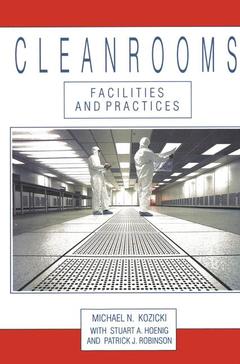Description
Cleanrooms, 1991
Facilities and Practices
Author: Kozicki Michael
Language: English
Keywords
Gas; Reer; automation; cleanroom; cleanroom technology; coating; cooling; heating; manufacturing; semiconductor; semiconductor technology; water
Publication date: 04-2012
374 p. · 15.2x22.9 cm · Paperback
374 p. · 15.2x22.9 cm · Paperback
Description
/li>Contents
/li>
In writing this book, our goal was to produce a much needed teaching and reference text with a fresh approach to c1eanroom technology. The most obvious technological reason for bringing this book into being is that c1ean rooms have become vital to the manufacture and development of high technology products in both the commercial and military sectors, and there fore people have to develop an understanding of them. Examples of c1ean room applications include the manufacture of integrated circuits and other electronic components, preciSion mechanical assemblies, computer disks and drives, compact disks, optical components, medical implants and prostheses, pharmaceuticals and biochemicals, and so on. The book is written for anyone who is currently involved, or intends to become involved, with c1eanrooms. We intend it to be used by a wide range of professional groups including process engineers, production engineers, plant mechanical and electrical engineers, research engineers and scientists, managers, and so on. In addition, we believe it will be beneficial to those who design, build, service, and supply c1eanrooms, and may be used as a training aid for students who intend to pursue a career involving controlled environments and others such as c1eanroom operators and maintenance staff. We have attempted to steer clear of complex theory, which may be pursued in many other specialist texts, and keep the book as understandable and applicable as possible.
1. Introduction to Cleanroom Technology.- The Need for Cleanrooms.- An Overview of Semiconductor Technology.- Other Cleanroom Applications.- The Impact of Cleanroom Technology.- 2. Microcontamination.- Types of Contamination.- Sources of Contamination.- Effects of Contamination.- Summary.- 3. Controlled Environment Concepts.- Performance Considerations.- Performance Standards.- Parameter Measurement.- Summary.- 4. Creating Clean Areas.- Construction Materials and Techniques.- Air Filtration.- Airflow.- Equipment and Material Decontamination.- Bringing Items into the Cleanroom.- Summary.- 5. Cleanroom Layout.- Mixed Flow Rooms.- Local Unidirectional Flow.- Modular Cleanrooms.- Tunnel Cleanrooms.- Total Vertical Laminar Flow.- Horizontal Laminar Flow.- Process Equipment.- Designing for Cleanroom Class.- Summary.- 6. Preconditioning, Control, and Static.- Air Handling Systems.- Fans and Air Control.- Static.- Summary.- 7. Site and Structural Considerations.- Vibration.- Site Selection.- Structure.- Internal Vibration Engineering.- Summary.- 8. Cleanrooms, Codes, and Legislation.- Principal Codes.- Fire Protection.- Legislation.- Summary.- 9. Ultrapure Water.- The Need for Ultrapure Water.- Constituents of Raw Water.- Purification Techniques.- RO/DI System Configurations.- Operational Considerations.- Summary.- 10. Production Materials.- Gases.- Wet Chemicals.- Handling Other Materials.- Summary.- 11. Personnel and Contamination.- Apparel.- Use of Apparel.- Work Practices.- Summary.- 12. Safety Issues.- Properties of Hazardous Production Materials.- Cleanroom Safety Practices.- Safety Equipment.- Handling Hazardous Production Materials.- Summary.- 13. The Future of Controlled Environments.- Advanced Cleanroom Concepts.- Enclosed Transfer Systems.- Robotics and Automation.-In-situ Processing.- Epilog—The Cleanroom as a System.- Appendix 1 Federal Standard 209D.- Appendix 2 Simplified Cleanroom Certification Procedure.- Appendix 3 Program and Sample Output.
© 2024 LAVOISIER S.A.S.




